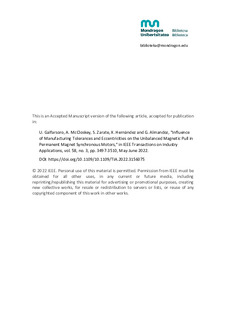Izenburua
Influence of manufacturing tolerances and eccentricities on the unbalanced magnetic pull in permanent magnet synchronous motorsEgilea (beste erakunde batekoa)
Argitalpen data
2022Ikerketa taldea
Accionamientos aplicados a la tracción y a la generación de energía eléctricaAcústica y vibraciones
Beste erakundeak
Orona EICBertsioa
PostprintaDokumentu-mota
ArtikuluaArtikuluaHizkuntza
IngelesaEskubideak
© 2022 IEEESarbidea
Sarbide bahituaBahituraren amaiera data
2024-03-31Argitaratzailearen bertsioa
https://doi.org/10.1109/TIA.2022.3156075Non argitaratua
IEEE Transactions on Industry Applications Vol. 58. N. 3. Pp. 3497-3510, May-June 2022Argitaratzailea
IEEEGako-hitzak
Rotors
Magnetic flux
Stators
Magnetic domains ... [+]
Magnetic flux
Stators
Magnetic domains ... [+]
Rotors
Magnetic flux
Stators
Magnetic domains
Harmonic analysis
Air gaps
Magnetic levitation [-]
Magnetic flux
Stators
Magnetic domains
Harmonic analysis
Air gaps
Magnetic levitation [-]
Laburpena
Eccentricity is an inevitable fault in electric motors and hence its diagnosis is an important topic. Thus, the influence of static and dynamic eccentricities on the harmonics of the frequency spectra ... [+]
Eccentricity is an inevitable fault in electric motors and hence its diagnosis is an important topic. Thus, the influence of static and dynamic eccentricities on the harmonics of the frequency spectra of the unbalanced magnetic pull is analyzed. In this article, dimensional tolerances of the rotor and the stator are also considered. All parts have dimensional tolerances in their designs and their real magnitudes vary to some extent from the theoretical values after the manufacturing process. Thanks to analytical calculations and finite element simulations, verified with experimental results, it is observed that the deviations originated by the manufacturing tolerances produce changes in the amplitudes of some harmonics and also additional and characteristic harmonics in the frequency spectra of the unbalanced magnetic pull. These are not negligible and must be taken into account when robust eccentricity detection procedures are defined. Otherwise, harmonics originated by tolerances and by eccentricities can be misidentified. Finally, after decoupling the effect of tolerances and eccentricities, the frequency harmonics that are indicators of rotor tolerances are determined, and a new methodology based on ratios of amplitudes of adjacent harmonics is proposed to identify eccentricities. [-]
Sponsorship
Gobierno Vasco-Eusko JaurlaritzaProjectu ID
info:eu-repo/grantAgreement/GV/Programa de apoyo a la I+D Empresarial Hazitek 2017/ZL-2017-00457/CAPV/Máquinas eléctricas con comportamiento vibro-acústico eficiente para el sector de la elevación/MECOVABildumak
Related items
Showing items related by title, author, creator and subject.
-
Analysis of non-uniform circumferential segmentation of magnets to reduce eddy-current losses in SPMSM machines
Madina, Patxi; Almandoz, Gaizka; Ugalde, Gaizka; Garcia Poza, Javier (IEEE, 2012)Eddy current losses generated in the rotor of the permanent magnet machines may lead to an excessive magnet heating. This can cause full demagnetization of the magnets so it is very important to analyze the losses on them ... -
Less Rare-Earth Electromagnetic Design for a High-Performance Permanent Magnet Motor
Rivera, Christian A.; Ugalde, Gaizka; Poza, Javier; Garramiola, Fernando; Badiola, Xabier (MDPI, 2022)This paper presents an electromagnetic design alternative using the so-called banana-shaped magnets, achieving magnet weight reduction of 21.82% for the same performance as the baseline motor in the case study. Typically, ... -
The composite improved generalized steinmetz equation (ciGSE): an accurate model combining the composite waveform hypothesis with classical approaches
Arruti Romero, Asier; Anzola, Jon; Aizpuru, Iosu; Mazuela, Mikel (IEEE, 2024)Predicting core losses is a difficult task for designing magnetic components. Under triangular current waveforms the classical approaches work with duty cycles close to 0.5 but are inaccurate for high and low duty cycles. ...





















